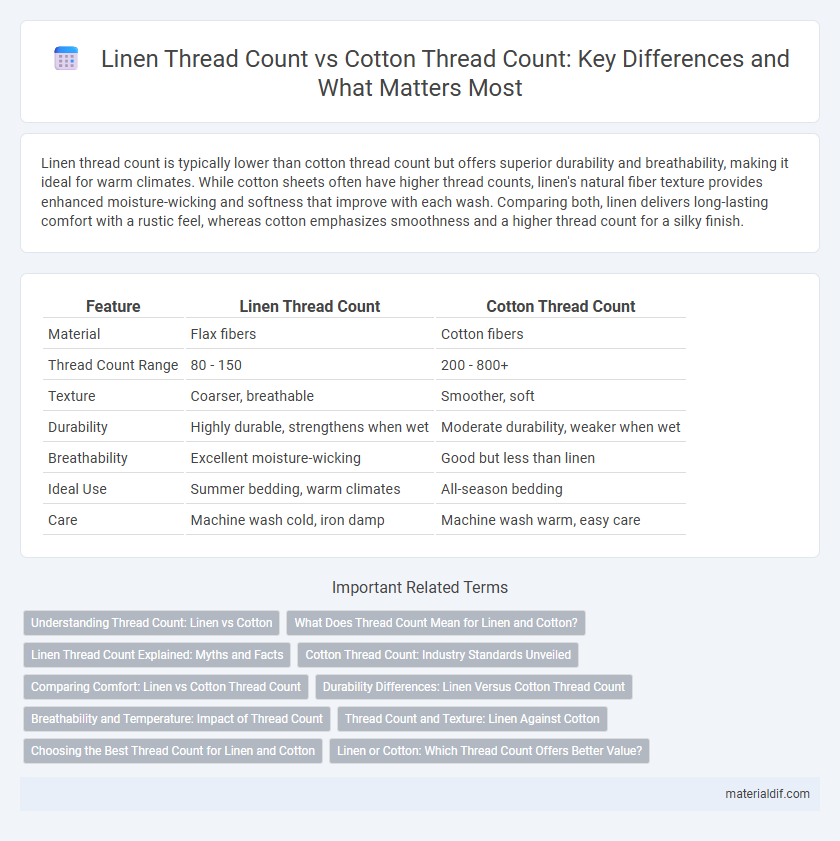Linen thread count is typically lower than cotton thread count but offers superior durability and breathability, making it ideal for warm climates. While cotton sheets often have higher thread counts, linen's natural fiber texture provides enhanced moisture-wicking and softness that improve with each wash. Comparing both, linen delivers long-lasting comfort with a rustic feel, whereas cotton emphasizes smoothness and a higher thread count for a silky finish.
Table of Comparison
| Feature | Linen Thread Count | Cotton Thread Count |
|---|---|---|
| Material | Flax fibers | Cotton fibers |
| Thread Count Range | 80 - 150 | 200 - 800+ |
| Texture | Coarser, breathable | Smoother, soft |
| Durability | Highly durable, strengthens when wet | Moderate durability, weaker when wet |
| Breathability | Excellent moisture-wicking | Good but less than linen |
| Ideal Use | Summer bedding, warm climates | All-season bedding |
| Care | Machine wash cold, iron damp | Machine wash warm, easy care |
Understanding Thread Count: Linen vs Cotton
Linen thread count typically ranges from 80 to 150, significantly lower than cotton's thread count, which can exceed 400. This difference is due to linen fibers being thicker and stronger, providing durability and breathability despite the lower thread count. Understanding that a higher thread count in cotton indicates softness, whereas in linen, quality is better judged by fiber strength and weave rather than thread count alone, is crucial for selecting the right fabric.
What Does Thread Count Mean for Linen and Cotton?
Thread count refers to the number of horizontal and vertical threads woven together per square inch of fabric, directly impacting the texture and durability of linen and cotton. Linen typically has a lower thread count than cotton but compensates with thicker, stronger fibers that enhance breathability and longevity. Cotton's higher thread count often results in a softer, smoother feel, while linen's thread count emphasizes natural strength and moisture-wicking properties suitable for warm climates.
Linen Thread Count Explained: Myths and Facts
Linen thread count is often misunderstood since its fibers are thicker and longer than cotton, resulting in lower thread counts but higher durability and breathability. Unlike cotton, where a higher thread count directly correlates with softness, linen's quality depends more on fiber length and yarn twist rather than thread count alone. Myths about linen thread count being inferior to cotton ignore linen's natural moisture-wicking and strength properties that make it superior for breathable, long-lasting bedding.
Cotton Thread Count: Industry Standards Unveiled
Cotton thread count typically ranges from 200 to 800, with premium bedding starting around 400, reflecting the number of horizontal and vertical threads per square inch. Industry standards for cotton emphasize higher thread counts to indicate softness and durability, but excessively high counts above 800 often involve multi-ply threads, which may not improve quality. Unlike cotton, linen thread count is usually lower, around 80 to 150, relying on fiber strength and texture rather than density to determine fabric quality and longevity.
Comparing Comfort: Linen vs Cotton Thread Count
Linen thread count is typically lower than cotton thread count but offers greater breathability and moisture-wicking properties, resulting in superior comfort, especially in warm climates. While cotton thread count increases often lead to softer fabric, high-quality linen achieves a textured softness without high thread count due to its natural fiber strength. Therefore, comfort comparison favors linen for its cooling effect and durability, despite having a lower thread count than cotton.
Durability Differences: Linen Versus Cotton Thread Count
Linen thread count is typically lower than cotton thread count but offers superior durability due to its longer, stronger fibers. Unlike cotton, which becomes weaker when woven at high thread counts, linen maintains strength and resilience, making lower thread counts in linen more comparable to higher counts in cotton. The durability of linen thread count ensures longer-lasting fabric that withstands frequent washing better than cotton equivalents.
Breathability and Temperature: Impact of Thread Count
Linen thread count typically ranges lower than cotton but offers superior breathability due to its natural fiber structure that allows air to circulate more freely, keeping sleepers cooler. Higher cotton thread counts often create denser fabrics, which can trap heat and reduce airflow, impacting temperature regulation negatively. Therefore, linen's lower thread count contributes to a cooler sleep environment, making it ideal for warm climates or hot sleepers.
Thread Count and Texture: Linen Against Cotton
Linen thread count is typically lower than cotton due to its naturally thicker fibers, resulting in a coarser yet more durable texture. Cotton thread count often ranges higher, providing a smoother, softer feel but sometimes sacrificing longevity compared to linen's robust weave. The distinct texture of linen, combined with its breathable fibers, offers a crisp, airy fabric that improves with age, contrasting with cotton's plushness and varied thread density.
Choosing the Best Thread Count for Linen and Cotton
Linen thread count generally ranges from 80 to 150, offering exceptional breathability and durability compared to cotton, which often features thread counts between 200 and 800. Choosing the best thread count depends on fabric type: linen performs better at lower counts due to its thicker fibers, while cotton benefits from higher thread counts for a softer, denser feel. Prioritizing breathability and texture is essential--opt for lower thread count linen for robust air flow and higher cotton thread count for smoothness.
Linen or Cotton: Which Thread Count Offers Better Value?
Linen typically features a lower thread count than cotton but offers greater durability and breathability, making it a better value for quality and longevity. Cotton fabrics often have higher thread counts, which contribute to softness but can reduce airflow and durability compared to linen. Choosing linen thread count over cotton provides enhanced moisture-wicking properties and natural strength, resulting in products that improve with age and use.
Linen Thread Count vs Cotton Thread Count Infographic

 materialdif.com
materialdif.com